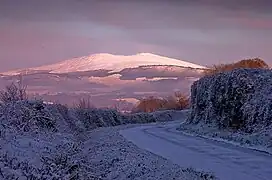
Kilcavan is an area in south County Wicklow in Ireland, approximately 5 kilometres (3.1 mi) north-east of Carnew. The area, comprising the townlands of Kilcavan Lower and Kilcavan Upper, is located at the southern end of the Wicklow Mountains.
Name
The Irish language name of the area is Cill Choamháin,[1] referring to a church (cill) associated with a person named Caomhán. Early anglicised versions of this name include a reference, in the Calendar of Patent Rolls of James I (1608), to Killkavane.[1] Other references include Kilkevine (1636), Killcavan (c. 1660), and Kilkeavan (1667).[1] 19th century records, attributed to place-name archivist John O'Donovan, refer to Cill Caemhain or "St Cavan's church".[1]
History
Former church
Near the R748 road between Carnew and the Kilcavan Gap, in Kilcavan Upper, is the site of an ecclesiastical enclosure. This circular enclosure is marked as the site of Kilcavan Church on mid-19th century Ordnance Survey maps. Today there is very little left of the church except scattered granite stones and a "crude Latin cross (WI047-006003-)" which is incorporated in a field boundary to the south of the church site.[2]
Kilcavan Church was named after Saint Caomháin, who founded the monastery of Airdne Coemain, now Ardcavan, County Wexford, c. 548. Caomháin may be the same priest named Caeman of Dairinis in other sources, who Saint Finnian of Clonard, visited before he went to Aghowle.
Quarrying
From at least 1800 until the early 1940s, the slate quarries of Kilcavan provided a source of employment for local inhabitants. The extracted slate, which was "of a dark colour",[3] was mainly exported, but also used locally and elsewhere within Ireland.
In addition to slate and stone for building,[4] the quarries at Kilcavan also exported the component used as a base for the "Battleship Gray" paint used on warships.[5] The slate quarry closed in 1942.[5]
Land use
In the very early nineteenth century the area was in the control of Lord Fitzwilliam and was originally leased only to Protestants.[6] This changed after 1808, and Catholics were given the chance to sub-lease land.
References
- 1 2 3 4 "Cill Chaomháin Uachtarach / Kilcavan Upper". logainm.ie. Placenames Database of Ireland. Retrieved 19 May 2023.
- ↑ Archaeological Inventory of County Wicklow, Dublin: Government Stationery Office, 1997,
WI047-006001- [Church] WI047-006002- [Ecclesiastical enclosure] WI047-006003- [Cross]
- ↑ Kinahan, George Henry (1889). Economic Geology of Ireland. Williams. p. 352.
In the southern part of the county, a little north of Carnew, are the Kilcavan slate quarries [..] The slate is of a dark colour and fair quality
- ↑ Lewis, Samuel (1837). "Carnew". A Topographical Dictionary of Ireland. Dublin.
At Kilcavan are quarries of building stone and slate, the latter of which is sent into the counties of Carlow and Wexford
- 1 2 "Carnew in Times Past". Wicklow People. 11 April 2002.
- ↑ "Nineteenth Century, Kilcavan". kennytree.com. Archived from the original on 1 September 2010.